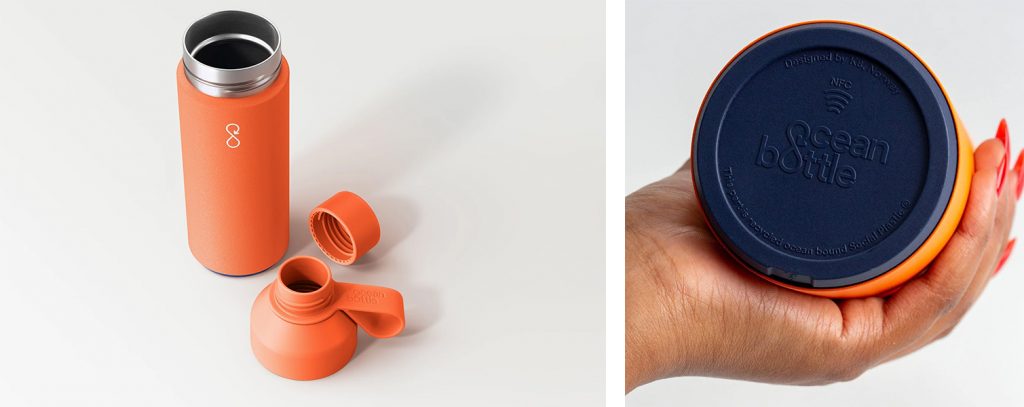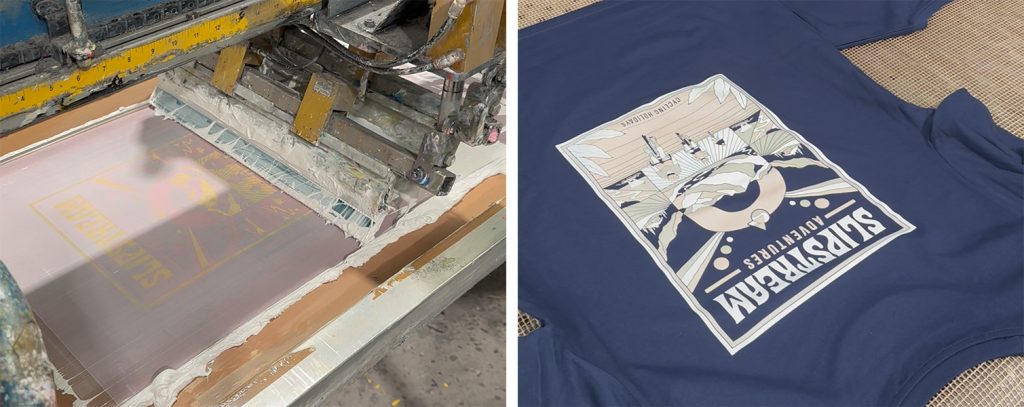Ocean Bottle is a B Corp certified reusable bottle brand.
With the sale of each Ocean Bottle, 11.4kg of plastic (the equivalent of 1,000 ocean-bound plastic bottles) is collected globally, in coastal areas where plastic pollution is worst. They work with plastic collection partners Plastic Bank, Plastics for Change and Repurpose Global to actualise this collection.
Their quality speaks for itself. Features include a dual opening to pour drinks and ice into and clean easily, hot and cold insulation, dishwasher proof and an easy carry loop.

The bottle is recyclable and part made from recycled ocean plastic. It comes embedded with an NFC enabled smart-chip, which allows owners to register the bottle to our Ocean Bottle Mobile App to further fund the collection of ocean-bound plastic (for free) each time a refill is registered.
Since launching in 2019 they have prevented over 9.1 MILLION kgs* of ocean-bound plastic from reaching our oceans.
The Ocean Bottle can be customised with your branding. Speak to us about how we can facilitate this for you.
*Correct as of 1 Jan 2024
The team at identity use a range of different decoration techniques to apply your branding and artwork to garments.
Below we have explained how each one works, and the benefits of each.

Silkscreen Printing
Silkscreen printing, also known as screen printing, is a versatile and popular printing technique that involves using a mesh screen to transfer ink onto fabric. This process is widely used for producing high-quality prints on textiles and apparel. It is also used for posters and signage.
How Silkscreen Printing Works:
- Screen Preparation:
- A fine mesh screen, traditionally made of silk (hence the name), nylon, or polyester, is stretched tightly over a frame.
- The screen is then coated with a light-sensitive emulsion or a similar material.
- Image Exposure:
- A stencil of the desired design is created on a transparent film or a light-blocking material.
- The stencil is placed on the coated screen, and the assembly is exposed to light.
- The light hardens the emulsion in areas not covered by the stencil, creating a template for the design.
- Washing and Developing:
- After exposure, the screen is washed with water or a specific solution.
- The unexposed areas of the emulsion dissolve, leaving behind the open mesh areas corresponding to the design.
- Printing:
- The screen is mounted onto a printing press.
- Ink is applied to the top of the screen, and a squeegee is used to push the ink through the mesh onto the substrate.
- The ink only passes through the open areas of the screen, creating the desired design on the substrate.
- Curing:
- The printed substrate is usually heat-cured or air-dried to ensure the ink sets and adheres properly.
Benefits of Silkscreen Printing:
- Versatility: Silkscreen printing can be used on a variety of materials, including fabric, paper, glass, metal, and plastic.
- Durability: The prints produced through silkscreen printing are often more durable and long-lasting compared to other printing methods.
- Vibrant Colours: Silkscreen printing allows for the use of vibrant and opaque inks, resulting in bold and vivid prints.
- Large Print Runs: It is cost-effective for large production runs due to efficient setup and faster printing speeds.
- Customisation: Silkscreen printing is suitable for both small and large-scale customisation, making it popular for personalised items.
Cons of Silkscreen Printing:
- Complex Setup: The initial setup process, including screen preparation and image exposure, can be time-consuming and require specialized skills.
- Limited Detail: Silkscreen printing may not be ideal for highly detailed or intricate designs compared to digital printing methods.
- High Initial Costs: Setting up screens and equipment can be expensive, making it less economical for small-scale or one-off projects.
- Not Ideal for Gradient Colours: Achieving smooth gradient colours can be challenging with silkscreen printing, as it typically relies on solid colors.
- Limited Substrate Compatibility: While versatile, some delicate or uneven surfaces may not be suitable for silkscreen printing.
In summary, silkscreen printing is a versatile and durable method suitable for various applications, particularly in large-scale production. However, its setup complexity and limitations in detail and colour gradients may make it less suitable for certain projects.
Heat Transfer Vinyl (HTV) Printing
Heat Transfer Vinyl (HTV) printing, also known as heat transfer or heat press printing, is a popular method for transferring designs onto fabrics using vinyl sheets and heat. This technique is commonly used in creating custom designs on clothing, bags, and other textile items. Here’s a step-by-step explanation of how heat transfer vinyl printing works along with its pros and cons:
How Heat Transfer Vinyl Printing Works:
- Vinyl Cutting:
- Your design is sent to a vinyl cutter, which cuts the desired pattern or text out of a sheet of heat transfer vinyl. The cutter follows the contours of the design, creating a stencil.
- Weeding:
- After cutting, the excess vinyl around the design (referred to as “weeding”) is removed, leaving only the parts of the vinyl sheet that will be transferred onto the fabric.
- Transfer Tape Application:
- A transfer tape is applied over the cut and weeded vinyl design to hold all the elements in place for transfer.
- Heat Press:
- The prepared design is placed onto the fabric, and a heat press machine is used to apply heat and pressure.
- The heat activates the adhesive on the back of the vinyl, causing it to bond with the fabric.
- The pressure ensures a strong bond, and the heat press is typically set to a specific temperature and time.
- Peeling:
- After the heat press process is complete, the transfer tape is carefully peeled off, leaving the vinyl design securely adhered to the fabric.
Pros of Heat Transfer Vinyl Printing:
- Customisation: HTV allows for easy customisation of designs, making it popular for personalised clothing and accessories.
- Versatility: It can be used on various fabrics and materials, including cotton, polyester, blends, and even some non-textile surfaces.
- Durability: Properly applied heat transfer vinyl can be durable and withstand regular washing and wear.
- Multi-Colour Designs: Different coloured vinyl sheets can be used to create multi-coloured designs without the need for layering.
- Small Production Runs: Ideal for small-scale production or one-off items, making it suitable for businesses and individuals.
Cons of Heat Transfer Vinyl Printing:
- Feel of the Design: The vinyl layer can feel thicker on the fabric compared to direct-to-garment printing or screen printing.
- Limitations in Detail: Achieving very intricate or detailed designs may be challenging compared to other printing methods.
- Not Suitable for Dark Fabrics: Light-coloured vinyl works well on dark fabrics, but dark-coloured vinyl may not show up as vibrantly on dark textiles.
- Labour-Intensive for Large Runs: For large production runs, the cutting and weeding process can be time-consuming and labour-intensive.
- Potential for Peeling: If not applied correctly, heat transfer vinyl may peel or crack over time, especially if subjected to frequent stretching or washing.
In summary, heat transfer vinyl printing is a versatile and accessible method for creating custom designs on fabrics, providing a balance between customisation and durability. However, it may have limitations in achieving very detailed designs and might not be the optimal choice for large-scale production runs.

